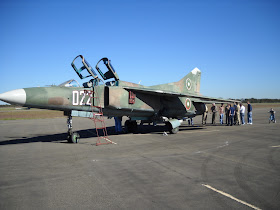
 We told the story previously about all the rain we've had. Some of that rain may have weakened the fill under an area of our ramp, allowing the left wheel to break through the surface. Since this was the same side that sank in the mud earlier, a reader asked if the plane was heavier on that side (No). After lifting the plane and patching the ramp, we were soon again on our way.
We told the story previously about all the rain we've had. Some of that rain may have weakened the fill under an area of our ramp, allowing the left wheel to break through the surface. Since this was the same side that sank in the mud earlier, a reader asked if the plane was heavier on that side (No). After lifting the plane and patching the ramp, we were soon again on our way.With no further problems, Jon "piloted" the bird out to a clear area of the ramp, taking care to place her as far as practical from the most active taxiway and with the blast area directed away from parked aircraft. (Jon, I don't think this counts as "PIC" time).
 With the aircraft in a safe area, it was time to give her a "treat", some Jet-A. The massive quantities of liquid hydro-carbons this bird consumes will soon be moving the museum into a whole new area of fuel purchase experience. Note the shadow with the wings full aft!
With the aircraft in a safe area, it was time to give her a "treat", some Jet-A. The massive quantities of liquid hydro-carbons this bird consumes will soon be moving the museum into a whole new area of fuel purchase experience. Note the shadow with the wings full aft!After a successful start up, all movable control surfaces were exercised. Note the flap and slat deployment. From this angle it is hard to get the full effect of seeing the wings swing. Look at the shadows on the ground to help see the movement from full extension to aft positioning.
With the wings tucked back, it was time to bring up the power. An afterburner run-up is not possible with just brakes and chocks holding the aircraft. The front strut is depressed in this run-up to 100% power, just shy of first-stage afterburner.
 After shut down, one of the techs went over to check the tail. Like puppies, everyone else followed.
After shut down, one of the techs went over to check the tail. Like puppies, everyone else followed. There must be something fascinating about looking at aircraft tails. At most airshows and at all of our student events, the boys always come around to look. Everyone seems to want to try and figure out how this hole can turn up to $12.00 worth of hydrocarbons into hot air every second. Perhaps they are seeking to understand how a segment of the American economy accomplishes similar (but much more expensive) results without being nearly as entertaining.
There must be something fascinating about looking at aircraft tails. At most airshows and at all of our student events, the boys always come around to look. Everyone seems to want to try and figure out how this hole can turn up to $12.00 worth of hydrocarbons into hot air every second. Perhaps they are seeking to understand how a segment of the American economy accomplishes similar (but much more expensive) results without being nearly as entertaining.

This comment has been removed by the author.
ReplyDeleteI'm loggin' it! ~ Jon
ReplyDelete